Let’s begin this week by welcoming the newest recruit to our Viking crew, Christian Golden, whose presence here greatly expands the number of doctorates we have on offer, and who maintains a damn fine pop culture blog of his own. Take it away, Dr. G!
Wolverine Max #6 (Marvel, $3.99)
By Christian M. Golden, Ph.D.
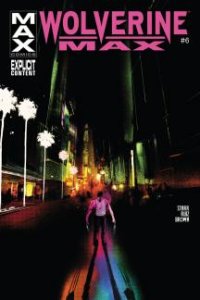 christian.m.golden@gmail.com
christian.m.golden@gmail.com
Though I harbor a fondness for the X-Men that has its roots in my adolescent love affair with Claremont and Davis’s Excalibur, I’ve long been wary of venturing into the Byzantine, soap operatic psychodrama that is the X family of titles. In all of superhero comicdom, the X-saga has always seemed the most incestuous and beholden to eons of intimidating continuity. So I was elated when I noticed that Marvel was introducing a Wolverine title under the MAX heading. No Sisyphean backstory research to cramp my brain! No pressure to invest in dozens of tie-in titles I might otherwise not care for! And Wolverine seems ideally suited for release into the wilds of profanity, ultra-violence and other groovy “explicit content.”
Launched in October 2012, the series so far is only six issues deep, the first five of which compose the first arc that wrapped last month. Issue #1 opens onto a wreckage of a downed plane off the coast of Japan, with a mind-wiped Logan regaining consciousness as the only survivor. The authorities are baffled by his miraculous recovery from the loss of both legs in the crash, which reveals that the MAX version of Logan lacks an adamantium skeleton, though his claws are intact. Suspected of having caused the crash, Logan wanders Japan piecing his past together one bloody bar fight at a time, eventually placing the blame where it belongs, on the Yakuza-hired Victor Creed. Creed has dogged his footsteps for centuries, repeatedly offering Logan a venue for unleashing his savagery through a life of crime. But with his memories slowly resurfacing, our hero again resists Creed and restores the honor of the Yashida clan to which his great love Mariko belonged 150 years before.
Issue #6 finds Logan in Los Angeles, having fled there to evade prosecution for his involvement in the Japan debacle. He’s after a fresh start, slumming it on the beach and living anonymously out of the back of a pickup with his sole companion, a German Shepherd aptly named Dog. His life has begun to echo the monastic practice that flashbacks in earlier issues revealed he sought years before in Japan. But, as we all know, everything changes when our frolicking Fido collides with a redheaded British porn star on the beach.
After an awkward introduction, the “explicit content”-appropriate Jean Grey lookalike, Candace “Candy” Cassidy, hires Logan on as a driver. Logan is glad to have some companionship until things go sideways and he breaks character, wasting several heavies in an effort to rescue her from what looks like an attempted rape by one of her shady clients. Later, Candy invites Logan to console her with PTSD sex, which Logan shrewdly declines.
Incidentally, this makes the second time in six issues that Logan is offered “heal me through your sex”-sex by a lately traumatized woman. In issue #3, an Edo-period Markio, having just learned of her father’s murder by hired assassins (of whom Logan was one, albeit unknowingly), refuses bereavement in favor of sex with the hairy Canadian: “No, I don’t need to grieve. But I need to feel something.” Another blow scored (another score blown?) for feminism by superhero comics.
The series’ current writer Jason Starr is an able graphic storyteller. He has worked on high-profile characters in Marvel, D.C. and Vertigo but is well-known outside comics as an author of crime fiction novels. So it’s unsurprising that Wolverine MAX has a decidedly noir feel. And it works.
As befits what is essentially a suspenseful crime drama, the book’s pacing is brisk and Starr’s dialogue is lean and utilitarian. Penciler Felix Ruiz, who handled the flashback sequences to Tokugawa Japan in the series’ first arc, returns to issue #6 alongside Kim Jacinto and Guillermo Mogorron. Their rugged, rough-hewn style nicely complements the accelerating pace of the narrative as it unfolds towards an explosive culmination when Logan reluctantly unsheathes his claws (“So much for staying out of trouble.”) and makes short work of a would-be rapist and some armed thugs. His rage boils over in the final, full-page panel revealing that his beloved Dog has been slain by unseen enemies. The overall effect is bracing and fun if you like excessive violence carried out by The Loner archetype, which I do.
But so far there are some real wasted opportunities in Wolverine MAX. As with Garth Ennis’s 2004 incarnation of Frank Castle, we are to assume that Wolverine’s MAX story is out of continuity with the rest of the Marvel Universe. The obvious merit of removing a central character from his usual context is that it defamiliarizes him, opening him up to reinvention. But this is exactly where Starr has yet to deliver.
Look at it this way: there really isn’t much obscene content in the book. When the profanity or violence exceeds what would be normally permitted, it feels like window dressing, adding nothing essential to the characterization. Explicit content doesn’t require a grand justification, but it’s hard to see how a smattering of just-for-fun f-bombs and some graphic decapitation could justify launching a title about a character with several existing books to his credit.
So what could?
Well, opening the door to explicit content can permit an exploration of the uglier and more problematic aspects of a character that is as inherently violent and internally conflicted as Wolverine. In issue #3, during a tender scene with Mariko in which Logan realizes that he was an unwitting party to her father’s murder, he says “I don’t know what kind of man I am.” But Starr does little to play up the moral ambiguity of being an indestructible, amnesiac killing machine with no ties to anyone. This is especially peculiar given that Wolverine’s utter isolation is all the more salient in a MAX universe so far devoid of the only family he has ever known: the X-Men.
A MAX grade Wolverine needs to do more than cuss to be worth the investment. The book is just starting out, but so far we’ve got a story that’s fun but lean on novelty and takes few chances with the character’s psychology. The compelling drama of Logan’s story resides in his perpetual war with the beast within. Yet Starr’s Wolverine is shown to be naturally compassionate, instinctively resisting Creed’s offers to join him in a bold grab for power and routinely vocalizing his abhorrence of injustice. That these are Logan’s predispositions in the wake of catastrophic memory loss suggests that he might be tamer than we thought, that the savage Wolverine is a product of the company he keeps.
I think this misses an opportunity to examine the stubborn inertia of anger. Logan’s humanity means more when it is hard-won through his ambivalent struggle with rage and his good fortune in finding loving friends and allies who refuse to give up on him. His humanity is worth less when it comes naturally instead of being perpetually endangered.
Rating: 




Out of a Possible 5 Stars
Jupiter’s Legacy #1 of 10 (Image, $2.99)
By Jeb D.
This is the week that Before Watchmen trickles to a close: the last issue of the Comedian series finally makes its delayed appearance, and DC has evidently decided to drop the Len Wein-scripted “Epilogue” that was to be the multi-artist finale to what was either an inevitable expansion of the concept, or a crass cash-grab. I bring this up only to point out that fans may finally be getting fatigued with the comics industry’s continuing to mine Moore and Gibbons’ classic for insights about power, fascism, and spandex tropes and traditions that were pretty well addressed back in 1986. Still, that’s clearly not going to slow down Mark Millar, author of Jupiter’s Legacy, who has gone to that well more than perhaps any of his contemporaries (see The Authority, The Ultimates, 1985, Superior, Nemesis, Kick-Ass, War Heroes, etc.).
Not, of course, that Moore was the first to pose questions about the purpose, or the need, of superheroes in a world more or less recognizable as “ours” (the Marvel Universe was basically built on characters like Peter Parker, Ben Grimm, and Bruce Banner posing those questions; they may have tended to answer them in a rather simple-minded affirmative, but the asking was a form of revolution). And from Squadron Supreme to Marvels to Invincible to Kingdom Come to Astro City to Supurbia to The Boys to America’s Got Powers to… well, you get the point: this territory is much less fertile than it was twenty (or forty) years ago, so for a series like this to have much impact anymore, it’s gotta go beyond “What if there were really superheroes? And what if they had some of the same problems that we do?”
Jupiter’s Legacy gets off to a surprisingly measured start for a Mark Millar book: his trick bag of flash, vulgarity, gore and pop culture references is set aside for the introductory section, as a group of 1930’s adventurers are drawn by a dream to locate an island that promises, in some fashion, to help address the pain and problems of a world sunk in the Great Depression, and on the verge of another world war. The first section of the book sets this up smartly and efficiently; the dialog blends necessary exposition with a genuine longing for what would have seemed a “better world” to these folks, hints of mystical forces at work, and adventure to come. The brilliant Frank Quitely, reteamed with Millar for the first time since The Authority (I’m actually not sure I’ve seen him work with anyone but Grant Morrison since then), isn’t called upon to innovate here, but instead delivers straightforwardly effective storytelling, with his usual eye for the telling detail, as we make our way to the mysterious island. Colorist Peter Doherty employs a wonderfully muted palette here: there’s no attempt at faux monochrome, but the feel isn’t worlds away from a classic black and white film like King Kong.
And then things kind of come a cropper. Given that this is a ten-issue mini, Millar and Quitely probably had room to show, rather than simply tell in text boxes, of the transformation that takes place on the island, giving these explorers superpowers, so it’s reasonable to assume that’s a card they’re not yet ready to show. But that does make the transition to the “modern” world that these characters went on to shape, after the island granted them those powers, rather perfunctory.
That modern world, “our” world (set specifically in Obama’s second term), is more familiar Millar territory as we meet the children of these transformed heroes, inheritors of the “legacy” that will drive the series, and (in typical Millar fashion) they’re kind of jerks. There’s some vague reference to the characters’ unusual longevity (chronologically, they should be grandchildren, if not great-grandchildren, of the 1930’s characters), presumably as a result of their gaining their powers, but I suspect it’s really just a way to tie in the Great Depression with the state of the world economy today, something that is handled with a glib carelessness that undercuts Millar’s attempt at world-building.
In fact, there’s a sort of first-draft quality to a lot of the setup: we’re told the heroes created a near-perfect world, and one of their progeny complains that there’s “no one cool left to fight,” but at the same time that their parents are simultaneously engaged in a fierce aerial battle with a monstrous foe who “killed an entire alien race and destroyed half of Missouri.” Not only does it make the “no one cool” complaint feel a bit silly, but it suggests that this “real” world is just as plagued with supervillains and aliens as any run of the mill comics universe. Millar can’t seem to decide if eighty years of living in a world of superpowered beings would result in a “real” world or a “comic-book” one; or, rather, he wants to have it both ways, depending on the point he’s trying to make at any given time: on the one hand, there’s the Obama and “too big to fail” references; and on the other, kids buy their drugs from space-faring dealers.
The parents’ superteam, naturally, has their conflicts. The Superman analog lectures his disgruntled comrades: “Having these powers comes with certain responsibilities,” and he gets the predictable response about how punching bad guys isn’t the way to improve the world, etc etc etc.
That the kids will have parental issues pretty much goes without saying, but there’s not much to them beyond that: they have some powers, they’re pretty dickish, they wear flashier costumes than the oldsters, they talk rougher and do drugs. Some reject their legacy, some are overwhelmed by it, but as with the adult superteam, if Millar has any real ideas for conflicts or storylines that might bring something new to the “What if there really were superheroes?” reading list, he’s saving that for future issues.
Which, thanks to Quitely, might be worth taking a chance on. Without a Morrison script to work from, there’s less experimentation going on (so far), but even the relatively modest fight sequence is handled with a level of detail that is stunning without being showy. He manages to make the endless sequence of talking heads (with characters constantly telling each other things that they already know, for our benefit) flow smoothly, and his depiction of a psychic encounter which takes place during the battle is wonderfully creative and, with many thanks to Doherty, some of the most overtly beautiful pages of Quitely’s career.
It’s only a first issue; the story may yet take an interesting turn, the characters might step outside their cookie-cutters, some light may be shed on questions of lineage and legacy, and it promises many many more pages of art from one of today’s giants, aided by a brilliant colorist. There’s certainly worse ways to spend three bucks.
Rating: 




Out of a Possible 5 Stars
Digital First/Digital Only Rundown
by Graig Kent
I won’t say there’s a digital revolution happening, because digital comics have been happening for the better part of the past decade, but digital comics are coming on strong, stronger than they ever have before. Sure, the Big Two are putting their attention towards developing stories and series specifically to suit the medium, but it’s about more than just publishers taking an interest, it’s more important that creators do. When some of the top names in the industry like Mark Waid, Warren Elis and Brian K. Vaughan start taking a greater interest in the potential of digital comics as both a distribution method and storytelling outlet, it lends credence for other creators to do the same. The young turks, the new guys, they’ve known this is the DIY way to get your work out there for years, but with publishers and established pros alike vouching for the model and its barely-there pricing, it lends authenticity and draws more eyes.
Of course, it’s this level of accessibility that’s ultimately going to make digital a very difficult place to navigate if you don’t know what you’re looking for. Like cruising YouTube or Netflix or Hulu with nothing particular in mind, you can wade through countless titles in a dizzyingly short amount of time with your consumption not really registering. It’s so easy to pick through free first issues on Comixology, or devour half of Warren Ellis’ Freakangels in one sitting, but how do you keep track of what you want to go back to, how do you remember what you liked, and how do you know when a new issue is out? Given the various methods of distribution — a multitude of websites and apps — how does one keep it all sorted when it’s not all in one place. It’s not like the Comixology App or an RSS feed gives you the ability to sort your digital collection, active series versus already read, or subscriptions for ongoing series with notifications when new issues are released. Digital still has a way to go before it will truly top the physical experience. But in terms of actual product, it’s making broad strides.
Frost (Monkeybrain, Free/$0.99) is one of the latest titles from Monkeybrain — a digital-only publisher that’s now over 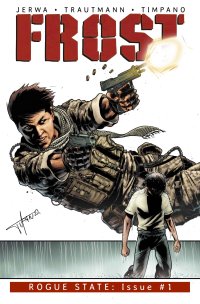 20 titles deep — the product of pro writers Brandon Jerwa (G.I. Joe, Battlestar Galactica) and Eric Trautmann (Checkmate, Vampirella), and up-and-coming artist Giovanni Timpano (G.I. Joe: Infestation, The Shadow). The “0” issue is a brief 6-page story, available for free on Comixology, but features a solid 5-page essay from Trautmann in the back that’s worth the price of admission alone (which, if you will recall, was free). In the essay “Blood & Bullets: The Paperback Origins of Frost” Trautmann gives a rundown on the history of all-American truck-stop-novel mercenaries like Mack Bolan and how they helped inspire a generation of cinema, television and comics. Frost aims to be a badass, but not bad as the churned-out pocket-novel products like Executioner and his derivatives wind up being.
20 titles deep — the product of pro writers Brandon Jerwa (G.I. Joe, Battlestar Galactica) and Eric Trautmann (Checkmate, Vampirella), and up-and-coming artist Giovanni Timpano (G.I. Joe: Infestation, The Shadow). The “0” issue is a brief 6-page story, available for free on Comixology, but features a solid 5-page essay from Trautmann in the back that’s worth the price of admission alone (which, if you will recall, was free). In the essay “Blood & Bullets: The Paperback Origins of Frost” Trautmann gives a rundown on the history of all-American truck-stop-novel mercenaries like Mack Bolan and how they helped inspire a generation of cinema, television and comics. Frost aims to be a badass, but not bad as the churned-out pocket-novel products like Executioner and his derivatives wind up being.
Trautmann has a strong interest in espionage and military, and his printed work largely over at DC (like The Shield and JSA/Kobra) really was a testament to how adept he is at writing this stuff, so in advance I knew he could be trusted to both deliver the action, the bad-ass character and not be so hoary about it. Make no mistake, Frost is definitely a “men’s action” product. The character is equally Jason Bourne as he is Mack Bolan, and the first 99-cent, 16-page issue really gets into it, how Frost’s past as a raised-from-childhood military weapon informs his current follow-his-own-path nature. Of course there’s gunplay, punching and explosions as well, but there’s actual character seeded in the midst of all that roughhousing.
[Rating 3.5]
 Moth City Season 1: Part 1 (Flying Whities/mothcity.com/, $0.99/Free) is militaristic but of a different sort. Set in an alternate version of the 1930’s, the titular city is a curious place located in South East Asia, an industrial, nation-independant island run by an American tycoon, dealing weapons and resources primarily to the surging Chinese communist military. The first issue (available on Comixology or or free at the series website) is centered around a chemical weapons deal between the city’s tycoon and a Communist General, which is a sketchy exchange at best. Writer/Artist Tim Gibson comes to comics from cinema storyboarding with a unique take on storytelling, working in an abstract chronology where the story will jump back minutes or days without notice before resuming the conversation-at-hand. It’s a little mystifying at first but it gets one’s attention and once the rhythm is established it becomes quite easy to digest.
Moth City Season 1: Part 1 (Flying Whities/mothcity.com/, $0.99/Free) is militaristic but of a different sort. Set in an alternate version of the 1930’s, the titular city is a curious place located in South East Asia, an industrial, nation-independant island run by an American tycoon, dealing weapons and resources primarily to the surging Chinese communist military. The first issue (available on Comixology or or free at the series website) is centered around a chemical weapons deal between the city’s tycoon and a Communist General, which is a sketchy exchange at best. Writer/Artist Tim Gibson comes to comics from cinema storyboarding with a unique take on storytelling, working in an abstract chronology where the story will jump back minutes or days without notice before resuming the conversation-at-hand. It’s a little mystifying at first but it gets one’s attention and once the rhythm is established it becomes quite easy to digest.
Gibson’s illustrative style is inelegant, but unique, and it conveys information smoothly and smartly. Fans of Matt Kindt or Jeff Lemire will be right at home in Gibson’s muddy, earthen world (his colour sense is what I groove on the most). Like Marvel’s “Infinite Comics” digital offering, Gibson takes advantage of the format by layering his panels with multiple “takes” giving the illusion of motion, one of the most alluring additions digital comics brings to the table. As well, the programming that backs these comics allows the creator an increased control over the reading experience, pacing the panel reveals and reading order that contribute something else unique to the reading experience. Gibson uses both of these techniques masterfully, moreso than any other digital-only I’ve read, and with a story whose purpose isn’t to just show off these things. It’s great stuff.
Rating: 




Out of a Possible 5 Stars
Like Moth City, Thrillbent comics are being offered on-line for free and in some cases on Comixology for a cost. I’m not really sure there’s security in this business model but it’s something Thrillbent’s founders Mark Waid and John Rogers seem keen on exploring and evolving, redefining the model (and the medium and technology) as they go. One innovation forthcoming is the ability to embed their comics on a webpage or social media site ala a YouTube video.
For now, their offerings are works-in-progress, at least in the formatting. Structured in panels, rather than pages, eash “issue” on the site can runs anywhere from 15 to 40 steps, which I imagine are about 6 to 15 “normal” comic pages worth of story, so each issue can feel slight. It’s noticeable in a series like The Damnation of Charlie Wormwood (Thrillbent, Free), where three issues in and we still haven’t come fully to the premise (“With his son’s life at stake, a college professor treads a dangerous path to earn some side money”). Writers Christina Blanch and Chris Carr and artist Chee are building character and situation but feels a bit too methodical, especially with where it’s leading already spoiled, as it were, by the series description. Charlie Wormwood is a professor, teaching courses to prison inmates interested in getting a degree, on of them seems far more aware of Charlie’s family situation than he should be, and tempts him with a side job (yet to be revealed by it’s current third issue). It’s playing off of Breaking Bad, to be sure, but we’re still at least one issue away from understanding what the crux of the series is.
Rating: 




Out of a Possible 5 Stars
The first issue of The Eighth Seal (Thrillbent, Free/$0.99) is a bit more robust, feeling more like a complete first issue,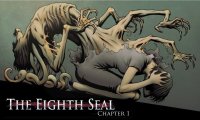 building towards a reveal that should propel the rest of the story. There’s a raising of the stakes in that reveal, the difference between a teacher and a woman of power dealing with traumatizing visions of demons that, if the title has any relevance, might be spelling the end of the world. It’s a horror story from writer James Tynion IV (Talon, Batman) that features an actual moment or two of horror, which is often hard to come by in comics. In this case, I think the fact that the issue is revealed panel-by-panel allowed the story to have the shocks come as a gruesome surprise (in physical form, seeing the whole page layout when you turn the page cans sometimes spoil the storytelling somewhat). Artist Jeremy Rock provides tremendously clean artwork that is so thorough in its real-world sensibility that it really exacerbates the grotesqueness of the demonic visions. Tynion IV has come out of nowhere into high profile work as an exciting new writer, and this looks to be an intriguing and necessary deviation from the Batman world he’s otherwise focused on.
building towards a reveal that should propel the rest of the story. There’s a raising of the stakes in that reveal, the difference between a teacher and a woman of power dealing with traumatizing visions of demons that, if the title has any relevance, might be spelling the end of the world. It’s a horror story from writer James Tynion IV (Talon, Batman) that features an actual moment or two of horror, which is often hard to come by in comics. In this case, I think the fact that the issue is revealed panel-by-panel allowed the story to have the shocks come as a gruesome surprise (in physical form, seeing the whole page layout when you turn the page cans sometimes spoil the storytelling somewhat). Artist Jeremy Rock provides tremendously clean artwork that is so thorough in its real-world sensibility that it really exacerbates the grotesqueness of the demonic visions. Tynion IV has come out of nowhere into high profile work as an exciting new writer, and this looks to be an intriguing and necessary deviation from the Batman world he’s otherwise focused on.
Rating: 




Out of a Possible 5 Stars
 The Pursuit of Beautiful Things (Independent ,$0.99) is a 16-page one-shot in the Monkeybrain structure that seems like an excerpted chapter from a larger work. The story takes place aboard a boat, where an honourable man and his dog were rescued at sea after disaster struck, only to find the company they keep to be less than the same. The men are crude and primal, barely men at all, and they’re in search of a mythical bounty that only deepens their shamelessness. It’s a short, but beautifully told and rendered tale from writer W. Maxwell Prince and artist Thomas Kovach, whose style is somewhere between Teddy Christiansen and Mike Mignola, so perfect for the tale at hand. I wouldn’t mind seeing this extended to a greater anthology starring the unintended adventures of this man and his dog, like an aged TinTin.
The Pursuit of Beautiful Things (Independent ,$0.99) is a 16-page one-shot in the Monkeybrain structure that seems like an excerpted chapter from a larger work. The story takes place aboard a boat, where an honourable man and his dog were rescued at sea after disaster struck, only to find the company they keep to be less than the same. The men are crude and primal, barely men at all, and they’re in search of a mythical bounty that only deepens their shamelessness. It’s a short, but beautifully told and rendered tale from writer W. Maxwell Prince and artist Thomas Kovach, whose style is somewhere between Teddy Christiansen and Mike Mignola, so perfect for the tale at hand. I wouldn’t mind seeing this extended to a greater anthology starring the unintended adventures of this man and his dog, like an aged TinTin.
Rating: 




Out of a Possible 5 Stars
Finally, there’s an offering from IDW, who seem to be using digital as a method of piloting new offerings instead of taking 
them to print first. Brooklyn Animal Control, offered up as a one-shot, 48-page story, is quite clearly intended as a launching point for an ongoing print series, as it doesn’t seem to take advantage at all of the medium’s capabilities or limitations (the panels are certainly structured for print). It’s not a wholly original concept, a sort of Men In Black deal where werewolves live among us, and Brooklyn Animal Control is responsible for policing them while also making sure the public doesn’t find out. But this isn’t a concept-driven book for a change.
Writer J.T. Petty has built a wonderful cast and a richly constructed history to the human-lycanthrope relationship. His story is constructed with enough character and family drama to be fully engrossing, but he also provides mystery and much conflict both physical and emotional and an appropriate sense of humour without undercutting anything (actually made me laugh out loud a couple of times). Where Hemlock Grove gets it all wrong, it’s all right here.
Art from Stephen Thompson is great. There’s so much that is distinctive and interesting in his character design,.. his close ups reveal such control and understanding of subtle facial expressions (where the majority of illustrators tend to go for broader expression). He’s also got as expert and impressive eye for natural detail. The flow of his action scenes are a bit jumpy, but otherwise its a great looking book (with masterful coloring from Len O’Grady). This is honestly one of the best new genre reads of the year, and I’m eagerly anticipating the ongoing series, whether digital, print, OGN, whatever. I want more.
Rating: 




Out of a Possible 5 Stars
There’s so much digital content out there, and at such a low price, if any, that pretty much the only thing it costs you is time. The most challenging aspect to much of it is waiting for (or just wanting) more of the comics you really key into.
Wonder Woman #19 ($2.99, DC)
Superman #19 ($2.99, DC)
By D.S. Randlett
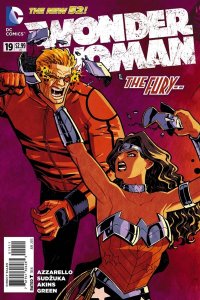 We’ve written a few paeans to Brian Azzarello’s run on Wonder Woman around these parts. It is one of the few bright spots in DC’s Two-Years-Old 52 effort, largely by virtue of being what the rest of the line should be: a more or less isolated rediscovery of the title character. Over the course of the run, Azzarello has demonstrated a keen insight into what makes the character work while throwing Wonder Woman herself into a situation that calls her primary beliefs to the floor, buttressed by an eye toward an examination of sexual politics and cycles of power. It’s the former theme that’s been receiving the most attention in the latest story arc and the arrival of Jack Kirby’s (rather bawdy) Orion. Orion has been sent to Earth to destroy the as yet unnamed child of Zeus and Zola, who apparently represents some kind of threat to the universe.
We’ve written a few paeans to Brian Azzarello’s run on Wonder Woman around these parts. It is one of the few bright spots in DC’s Two-Years-Old 52 effort, largely by virtue of being what the rest of the line should be: a more or less isolated rediscovery of the title character. Over the course of the run, Azzarello has demonstrated a keen insight into what makes the character work while throwing Wonder Woman herself into a situation that calls her primary beliefs to the floor, buttressed by an eye toward an examination of sexual politics and cycles of power. It’s the former theme that’s been receiving the most attention in the latest story arc and the arrival of Jack Kirby’s (rather bawdy) Orion. Orion has been sent to Earth to destroy the as yet unnamed child of Zeus and Zola, who apparently represents some kind of threat to the universe.
Looming in the background is the firstborn son of Zeus (simply called The Firstborn). This is, oddly, the only instance of continuity porn in this series, but it’s paying off an unresolved plot in Greek myth rather than some bit of DC Comics esoterica. The Firstborn is shaping up to be a pretty formidable villain: his strength and prowess are quite considerable, and here we see him conniving with Poseidon and Hades. There’s the possibility that he’s being played here, but he could also be the one doing the playing. Azzarello hasn’t really tipped his hand as far as The FIrstborn is concerned, but one suspects that there’s some bait and switch going on here between him and the lastborn that Orion has been sent to take care of. But of course, in the midst of all of these ancient prophecies, how will the decidedly modern heroes Wonder Woman and Orion fit in?
Over the course of his appearances in this series, there’s been a weird sort of sexual tension between Wonder Woman and Orion. Orion’s continually positioned himself as a sort of alpha male in Diana’s ragtag group of demigods, and this is the issue where Azzarello finally lets that shoe start to drop in a great scene and hilarious scene where Wonder Woman essentially puts Orion in his place. Seeing her be essentially passive to Orion’s advances has been somewhat troubling, but the payoff here is a lot of fun.
Wonder Woman’s art problems continue, however. Cliff Chiang’s voice has become essential to this book, and his issues are always the standouts. Even though his substitutes try, they just can’t match his clean lines, and adding even more visual confusion, the colorist seems to take a different approach to each penciller.
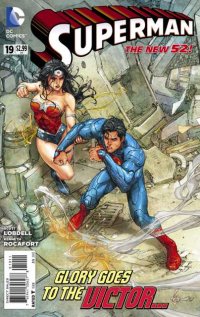 Meanwhile, over on Earth-Mediocre, Orion also appears in this month’s issue of Scott Lobdell and Kenneth Rocafort’s
Meanwhile, over on Earth-Mediocre, Orion also appears in this month’s issue of Scott Lobdell and Kenneth Rocafort’s
Superman. I can imagine that there are some continuity obsessives out there really fretting over the fact that the appearance of Wonder Woman and Orion in Superman doesn’t really mesh with what’s been happening in Wonder Woman. In a way, it’s what the DC needs more of. The DCU wasn’t overly concerned with continuity until Marvel became a contender (and really, quite a while after that). The conflict between Superman and Orion has nothing to do with any of the sexual tension in Wonder Woman and this run of Superman. Rather, Orion has been sent to Earth to take out Superman because he’s a potential Threat To The Universe… just like the baby in Wonder Woman.
And really, that’s fine, because it lets each book do its own thing. Azzarello’s Wonder Woman is a take that doesn’t take great pains to concern itself with legacy in order to say something on its own.Superman is almost pure product, which is a shame, as it contains some fun ideas and cool art. This issue of Superman opens strong with Superman defeating a visiting race made of red star matter in a fun and novel way, and Clark Kent taking Diana Prince as a date to Lois Lane’s housewarming party. It almost reminded me of some of those Swan/Bates Superman comics of yore, with demonstrations of Superman’s powers that either bordered on ridiculous or were just plainly flat-out ridiculous. Or the nearly sit-commy antics at the Daily Planet, especially as Hector Hammond sends out psychic waves to make the house party something of a mind trip for all involved.
It’s almost… good. Rocafort could be one of the great Superman artists if he were teamed with a writer that took a firmer hand in dictating how he tells his story. As it is, he’s really good at capturing the scale of Superman’s power, but his narrative style has no flow to speak of. While his drawings are undeniably pretty, there’s just no momentum. Then, there’s barely any momentum in the script. For all of Lobdell’s neat or fun ideas, there’s just nothing hooking them together. If there were, we might have something.
Wonder Woman–
Rating: 




Out of a Possible 5 Stars
Superman–
Rating: 




Out of a Possible 5 Stars